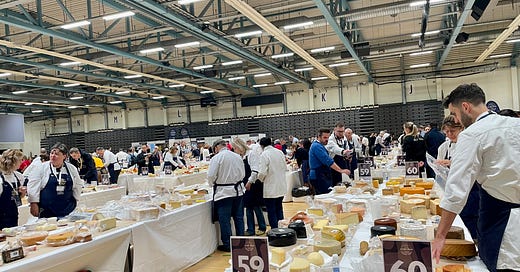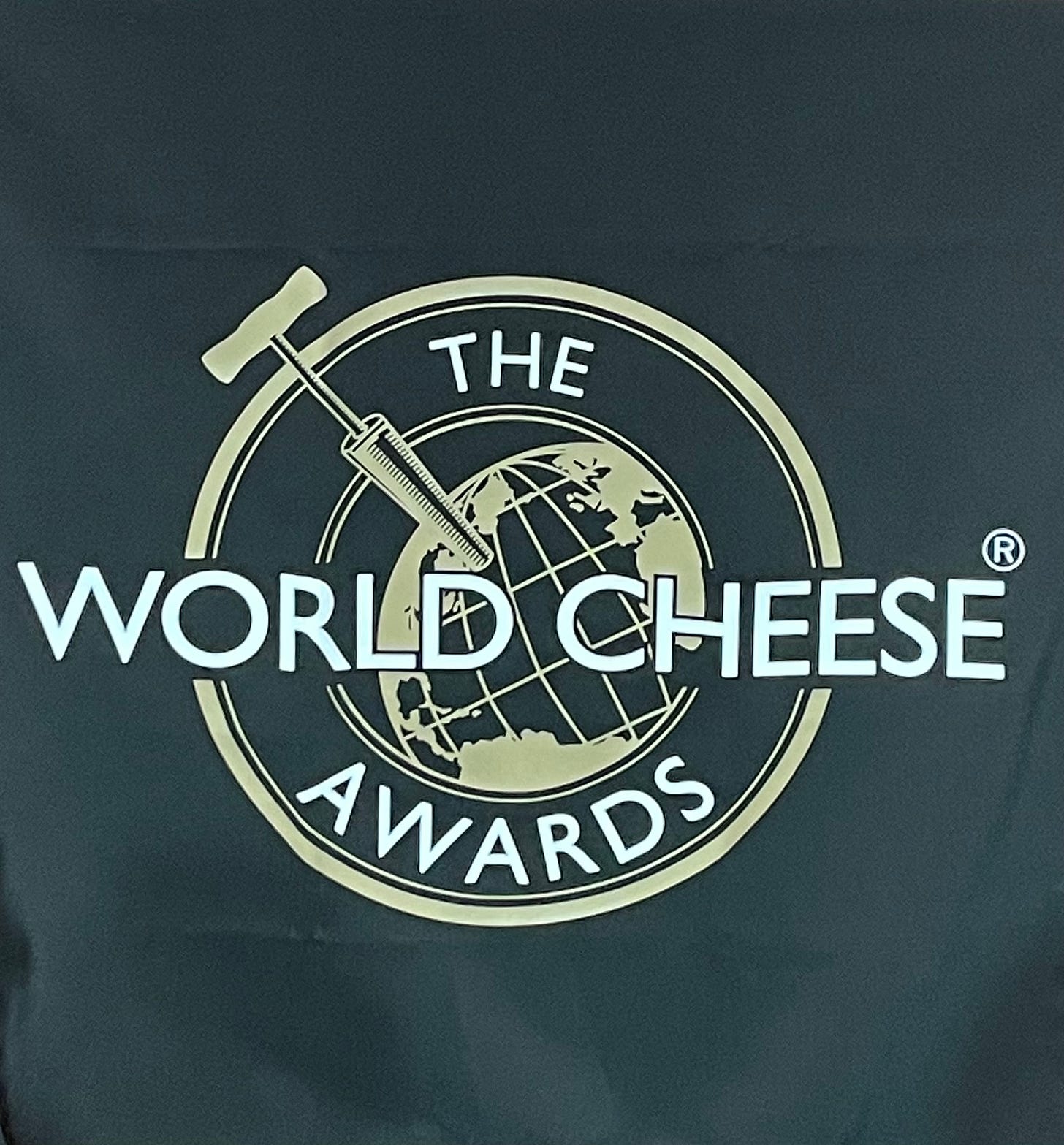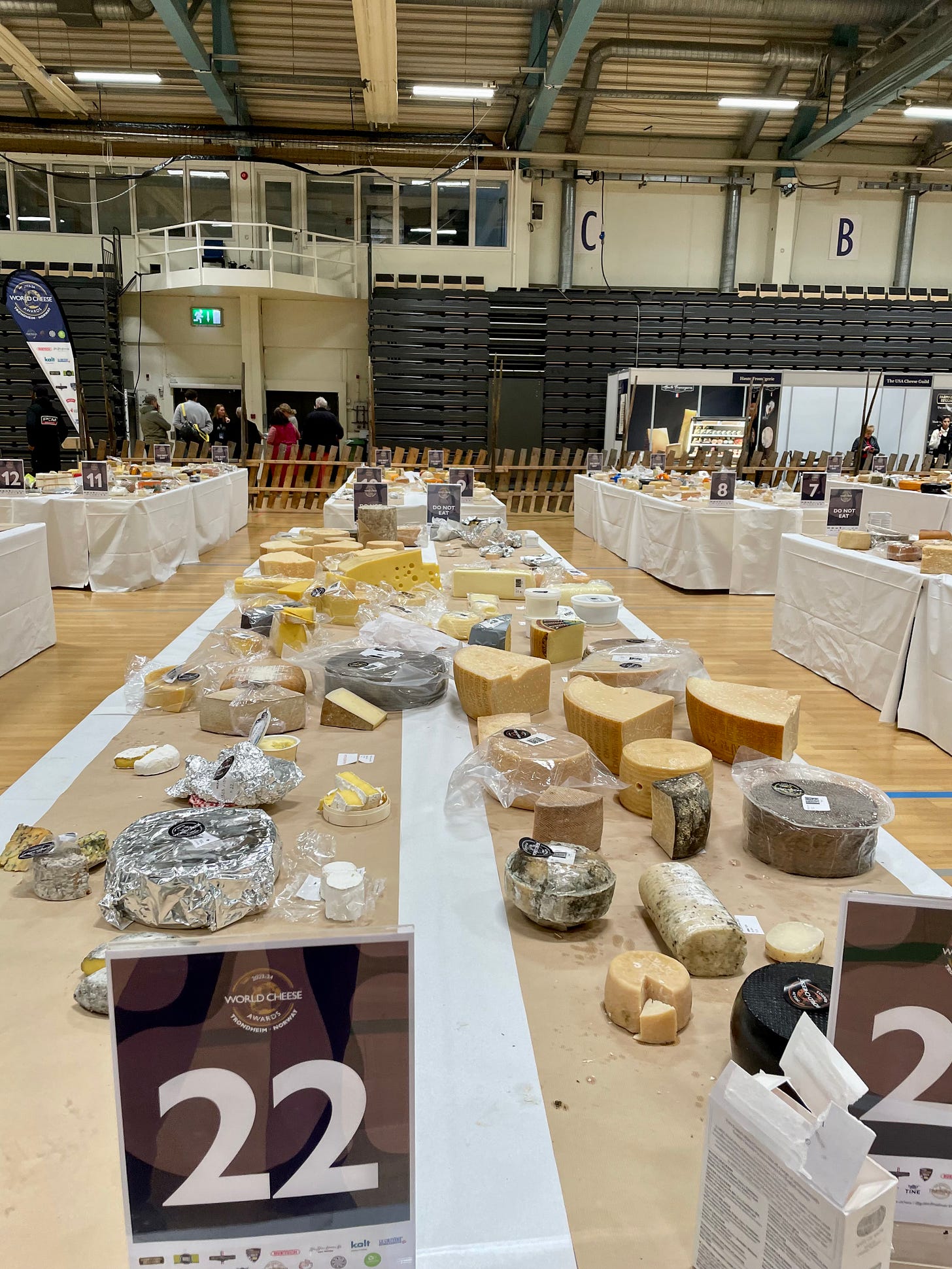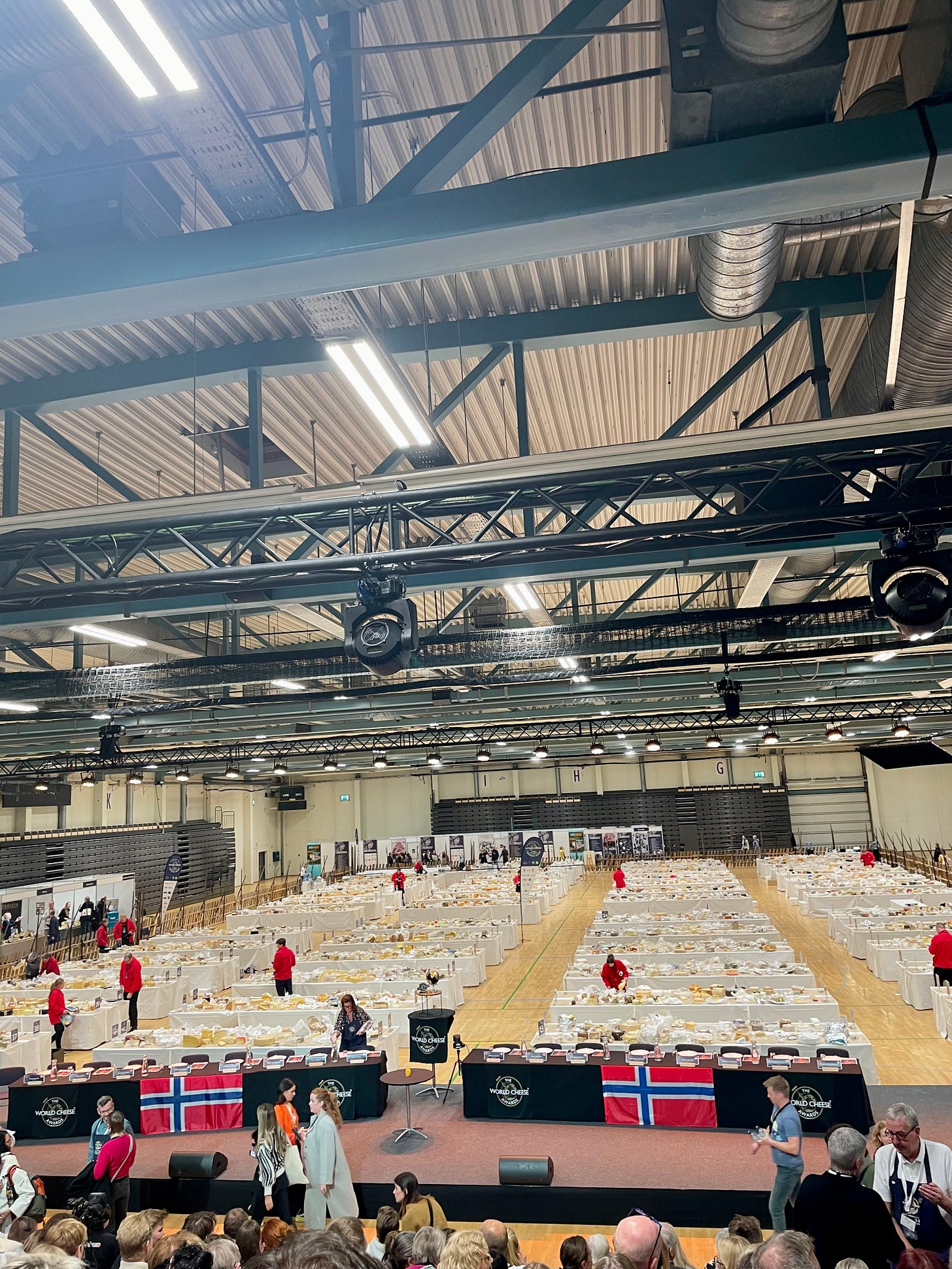Postcards From the World Cheese Awards: Cheese Judging
A First Timer's Thoughts and Take Aways From One of the Biggest Cheese Events in the World
World Cheese Awards, part 2
Welcome to the World Cheese Awards!
This October I had the opportunity to go to the World Cheese Awards in Trondheim, Norway! While I was just a spectator, it was one of the most exciting moments in my cheese career! For two days cheese, cheese enthusiasts, and the rock stars of the cheese world dazzled me. The next series of posts will cover this amazing experience, the things I learned, and the questions I left with.
The question I got the most when I got back from the World Cheese Awards was, “How do you judge a cheese?” The World Cheese Awards has a systematic and practical approach to tasting and judging cheese that is typical for the industry, but they must balance this with the extra consideration of the international nature of the competition.
As discussed in my last WCA post, the 2023 competition consisted of 4,502 cheeses arranged across 100 tables. At each table, two, sometimes three, judges assess their table’s cheeses. They award bronze, silver, and gold medals to the outstanding cheeses they encounter, and then select one Super Gold cheese to go to the Super Jury. Charlie Turnbull — cheese writer, educator, and Co-presenter for the WCA — explained how each judging team had a tablet on which they recorded the score for each cheese. The scoring template awarded a score out of 100. Judges assess cheeses “blind”: the only identifying information the judges receive is the milk used to make the cheese and its country of origin. Uniquely, submitted cheeses do not apply to compete in a specific category based on make type. For example, a bloomy-rind cheese does not just compete against bloomy-rinds, but it competes against all submitted cheese from all countries! Thus each table has an array of types and styles of cheeses for the judging team to taste, which reflects both the nature of the awards and prevents judges’ palettes from getting tired from tasting the same type of cheese 40 times.
How do you judge cheese though? We all can agree that taste is subjective and shaped by our genetics, experiences, and environment. It takes practice tasting cheeses over and over again, from batch to batch, to build up a vocabulary and sensitivity to nuances in flavor— between types of cheeses and between batches of cheeses. Cheese is a living, breathing thing and thus influenced by the seasons and its environment. Luckily, there are techniques beyond taste to assess the quality of a cheese. These include, but are not limited to, smell, rind development, and paste texture and development. Judges will check for cracks or irregularities on the rind and the uniformity of any mold or bacteria growth. For some cheeses, judges will take core samples with a tool called an iron. This allows them to see how the cheese has ripened from the inside out and taste the paste at the center. Some judges prefer cutting into cheeses to see a cross section and better see if there are any holes or imperfections in the paste created during the cheesemaking process (caused by insufficient or too much pressing of the curds into forms) or during the affinage (release of gases from cheesemaking bacteria). Some cheeses can be tapped with a special mallet, with the sound indicating whether there are any imperfections inside the cheese. Parmigiano Reggiano graders use this method.
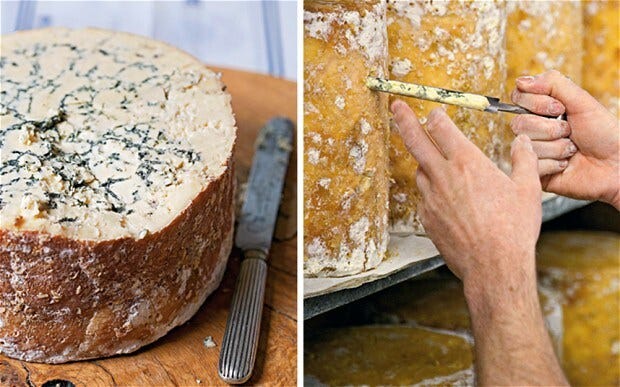
There are three points that I think are important to consider when regarding the results of this competition. First, as Charlie Turnbull put it best, the results reflect a snapshot of all 4,502 cheeses on one day. Tomorrow the world champion may not taste like a world champion. This is the nature of a living, evolving thing like cheese. Second, most of the cheeses had to travel thousands of miles to reach the judging arena and were subjected to temperature fluctuations, mishandling during transit, or just arrived a day after their peak ripeness. Sometimes cheeses are not able to be judged: they arrived too late and went bad along the way (RIP). The further away a cheese must travel— and the less reliable refrigerated transport available —the less likely a cheese is to receive an award at WCA. Last, WCA is still navigating how to be more internationally inclusive, and the greatest barriers are systematic. Import laws are a huge one: depending on the import laws of the hosting country, some cheeses are banned from entering. I saw this in the booths set up around the arena tasting out cheese. The Japan Cheese Association placed colorful paper origami cranes behind the names of artisan cheeses from their country because Norway would not let them bring in their cheeses for consumption. They were allowed to send cheeses to compete, but they could not sample out cheeses for the public.
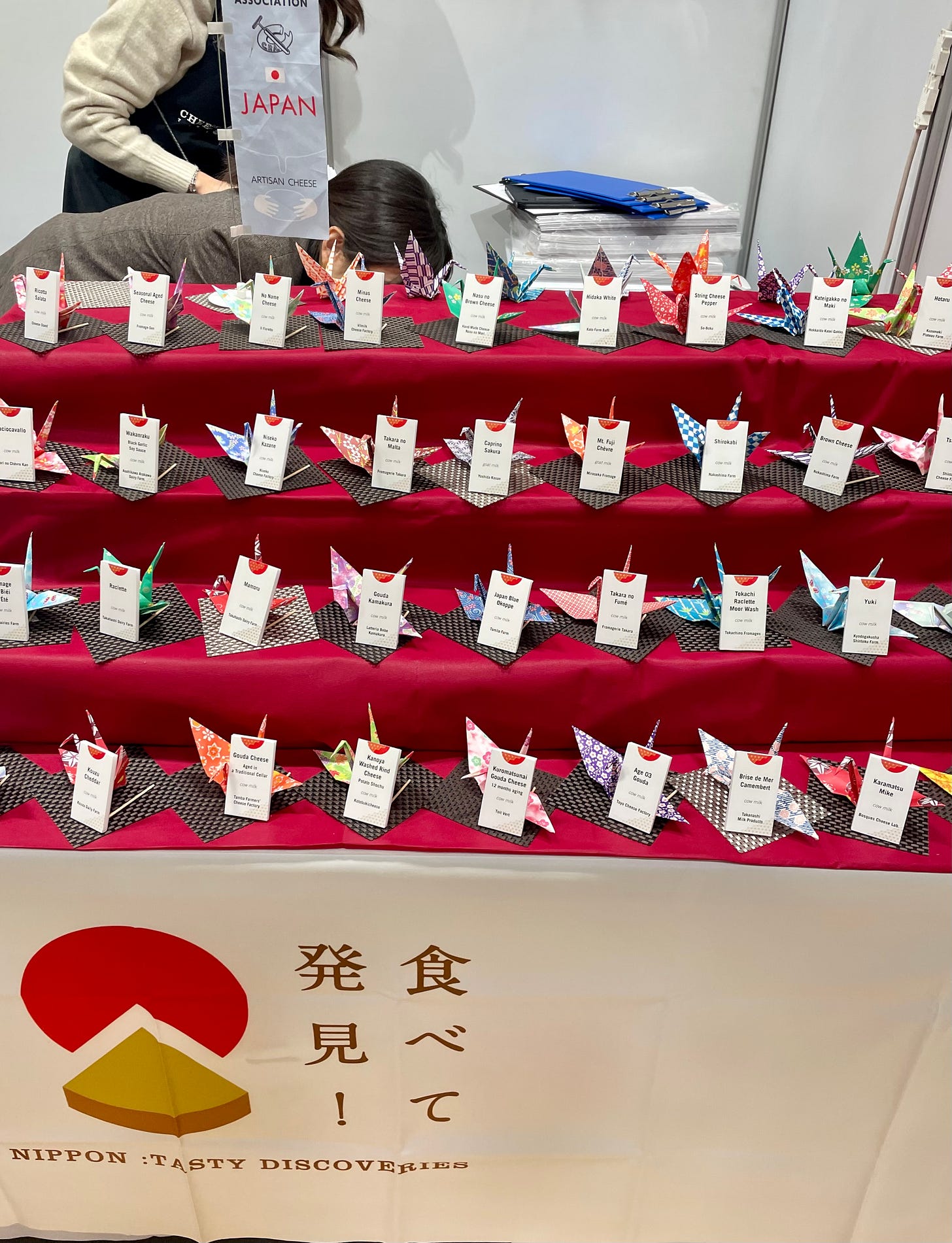
However, the WCA is trying to be representative. Case in point is the composition of the Super Jury. The Super Jury consists of 16 judges who are at the top of the industry in terms of authority and knowledge about cheese. The 2023 judging panel included:
Kelsie Parson (Canada)- He is one of only 16 Canadians to earn the American Cheese Society’s Certified Cheese professional (ACS CCP) certificate. Parsons is an authority of Canadian cheese, having worked for the biggest champions of Canadian artisan cheese. After a roadtrip across Canada, he is now working on a book on Canadian cheese.
Debora Pereira (France/Brazil)- originally from Brazil, Pereira splits her time between France and Brazil. In Brazil she is the director of SerTaoBras, an organization promoting Brazilian artisan cheese and cheese heritage, and writes a weekly column for the newspaper O Estabo de Sao Paulo. In France, she writes as a journalist for the Profession Fromager, has done research on the microbiology of cheese, and is a Mons Fromager affineur and teacher.
Svein Erik Backlund (Norway)- having worked for Oluf Lorentzen— the top cheese retailer in Noway —for over 20 years, Backlund has an extensive knowledge of cheese. He is a cheese trainer for all major retailers in Norway, and he is involved in selecting which cheeses enter the Norwegian market.
Georgina Yescas (Mexico)- Co-founder of Lactography, Yescas makes, ages, and sells Mexican artisan cheeses alongside her brother and partner. Since 2012, she has worked to support small producers throughout Mexico and promote Mexican cheeses internationally.
Patrick McGuigan (United Kingdom)- Cheese writer and educator, McGuigan’s writing has appeared in the Telegraph and on the BBC Radio 4, and he is the author and co-author of several books on cheese. He regularly teaches tasting and classes on cheese including for the Academy of Cheese. He has helped found cheese events in the UK, such as The Big Cheese Weekender— which encourages consumers to support and shop at their local cheese shop — and the London Cheese Project.
Cathy Strange (USA)- Strange has single-handedly changed US consumers’ cheese demand. The head of cheese buying at Whole Foods since 1990, Strange introduced US consumers to some of the best cheeses in the world as well as the American artisan cheese movement. So many cheesemongers and professionals got their start at the Whole Foods cheese counter. Name any cheese professional organization or competition and it is more than likely she is a member or has served as a judge. Strange has a new position at Whole Foods now: Food Culture Ambassador.
Aki Sakagami (Japan)- Director of the Japan Cheese Association, Aki is at the heart of promoting Japan’s artisan cheeses to the world. She is involve with Japan Cheese Co, which offers tours visiting Japan’s cheesemakers, and with Mons Fromager. Aki is a frequent judge at international cheese competitions.
Finbar Deery (Ireland)- Deery is the head of Retail at Sheridans Cheesemongers. Sheridans has been leading the way in the Irish artisan cheese revival for over 25 years. Finbar has helped spearhead this mission. He is currently pursuing a Master of Arts in Gastronomy and Food Studies at the Technological University of Dublin.
Catherine Fogel (Denmark)- Fogel is the owner of OLIVOTEQUE offering olive oil tours, tasting, and a selection of oils from all over the world. She also works as a culinary advisor, gastronomy advisor, olive oil taster and master blender, and a cheese expert.
Peter Martensson (Sweden)- In 1988, Masrtensson founded and opened Möllans Ost, a cheese shop with a mission of introducing Sweden to the cheeses of Europe he had enjoyed on his travels. The retailer has grown and is at the forefront of artisan and specialty cheese retail in Sweden.
Ana Belen Gonzalez Pinos (Spain)- Deeply entrenched in the food culture and gastronomy of Spain, Pinos wears many hats. Some of the many roles she fills include: content director of El Trotaqueserías (an online portal dedicated to disseminating Spanish cheese culture); brand ambassador and culinary advisor for cheese companies, restaurants, and retailer; member of the Con Mucho Gusto research group at the Complutense University of Madrid; teacher and co-director of university gastronomy programs; and a cheese writer.
Evert Schonhage (Netherlands)- One of two Maître fromager at Kaasfort Amsterdam, Schonhage also won the Best Cheesemonger in the World competition— the Mondial du Fromage held every other year in Tours, France —in 2019.
Suzy O’Regan (South Africa)- Head of Product Development for Woolworths, she works with South African cheesemakers to make high quality cheeses for the large food corporation. She is also only the second woman (and one of only nine) to be added to the South African Agri-Expo Roll of Honor. She has served as a judge for the South African Dairy Competition for over 20 years.
Jon Thrupp (United Kingdom)- Starting in 2006, Thrupp became the Borough Market Manager for Neals Yard Dairy as well as the co-founder and director of Mons Cheesemongers. In collaboration with Herve Mons, he selects, matures, and brings French and Swiss cheeses to the British market.
Davide Fiori Guffanti (Italy)- Alongside his brother and father, Guffanti helps run Luigi Guffanti, a multi-generational cheese maturing and export business. Sourcing cheeses from arounds the world, the Guffantis age them in a former silver mine and export them around the world. Despite their international reach, they also help to preserve the tradition and heritage of Italy’s long cheese history.
Mansi Jasani (India)- Known as Cheesewali on social media, Jasani founded The Cheese Collective in Bombay in 2014. After interning in the Murray’s cheese caves in 2012, Jasani was inspired to build this unique “phone-order and social media-based business, with equal parts sales, education, and cheesemaking.”
While the Super Jury is still Euro-centric, the Guild of Fine Foods— the UK organization that puts on the World Cheese Awards —makes an effort to give countries a seat at the table who are rising stars or lesser known cheese powerhouses. Many of these countries had cheesemaking introduced as a result of colonial oppression and imperialism but have since made cheeses unique to their culture and environment. However, historically they have been systematically, wrongly maligned as European knock-offs. By having experts in Mexican, Brazilian, Indian, Japanese, and South African cheeses part of the Super Jury is a step towards righting that perception, but there is still more that needs to be done. The audible gasp and then applause when an Indian cheese made it to the final 16 was the sound of a wave of change that I hope sweeps through the cheese industry.
On a personal note, being able to taste and evaluate cheese is a skill I hope to build in 2024. With that goal in mind, I signed up for the University of Vermont Artisan Cheese and Sensory Evaluation certificate course. I encourage everyone to taste, taste, and taste some more. Even if you have tried a cheese before and did not like it, try it again. Banish any preconceived notion you may have about a country’s or maker’s cheese and go in with an open mind. You never know what you will find.
Are you taking the Cheese and Sensory Evaluation course too? Have a question about tasting or judging cheese? Reach out or leave a comment!

